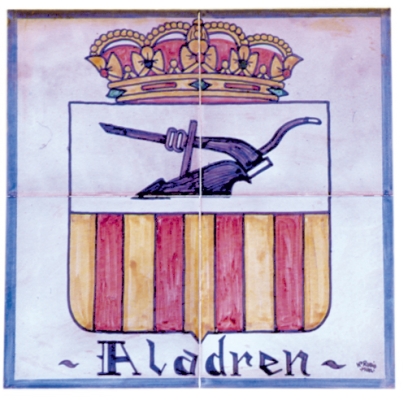
HERITAGE
In regards to the natural environment, it’s necessary to highlight the variety of landscapes and the geological interest in the surrounding area. “We’ve seen the different ages of the earth,” Geology students tell us every year that attend the “best lesson of the course.” Aladrén and a good part of its surroundings will surprise nature lovers and everyone who enjoys hiking. Its varied landscape adapts to different moods and capacities.
In the northwest and southeast both pinnacles are above 1000 meters with peaks and valleys of different shapes and sizes. There is a large forest of pine trees linked to the one in Paniza, while the south is mainly covered by kermes oak. There are also Sabin and Pyrenean oak together with rosemary, lavender and thyme, without forgetting a wide plateau to the North. Arable lands are spread over all the valleys. A few examples are: El pantano de las Torcas, located in the municipality of Tosos, 4 km away from Aldrén., diverse accesses lead to the most unknown and interesting part of Huerva’s river, Vistabella ,with idyllic spots alternating with rocky cliffs that house predatory bird nests.
The small tributaries and cliffs converge in La Huerva as “Los estrechos” in “El Barranco Hondo” canyon, last stretch of the river Tremolar, something unique from Aragon, at least to the south of the Pyrenees.
The main artistic heritage in Aladrén is located inside of the parish church since works which were in the two hermitages (San Clemente and Virgen de las Nieves) were moved away to avoid robberies. Nevertheless, it is interesting to visit them because of their locations, which dominate interesting landscapes.
It’s important to remark the recent reconstruction of a bread oven from the 18th century.
All authors say that the name “Aladrén” has its origin in the latin voice Aratrius (the farmer), accusative “aratorems.” Possibly, this place was founded during the late roman period, at that time many villas within the empire were founded too. It might have been earlier because it seems there were probably iron mines. According to Cornide the emplacement was not the current one, but it was closer. Maybe in a leafy valley over one kilometer from the current, site where many elements appear that require further studying.
After the Reconquista, together with Paniza and other close villages, Luco and Alcañiz de Huerva, which have disappeared but can be perfectly located, were donated by Alfonso el Batallador to his brothers Fruela and Pelayo, but we don’t know for how long. What we certainly know is that Urrea’s family was one of the main families from Aragón, founded by Maximiliano de Urrea who was a natural child of the German emperor that came to ask for help to Sancho Ramirez when taking Barbastro, and later on took the surname “Urrea.”
The first written document that makes reference to Aladrén is the will of Ximeno de Urrea leaving villages to his son and heir. They belonged to this family until Pedro IV el Ceremonioso, dissociated Juan Jiménez de Urrea for having rebelled against the king with the “union” of the nobles, who was defeated in Épila by the royal army in July 1348, commanded by Sir Lope de Luna.
Country house
ANA MARI C/ La Fuente,13